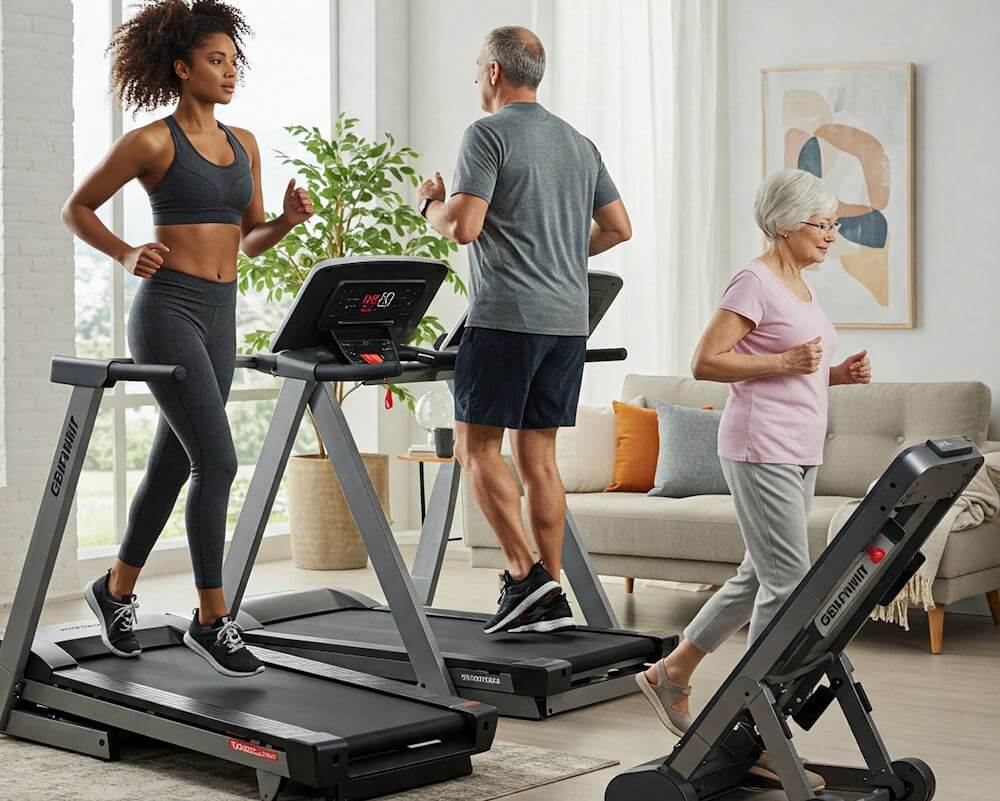The concept of a home gym has gained considerable popularity in recent years, as more individuals recognize the advantages of exercising in their own space. The increasing trend towards at-home workouts can be attributed to various factors, including the demands of modern life and the desire for convenience. A home gym allows individuals to incorporate fitness seamlessly into their daily routines, offering the flexibility to choose when and how to work out.
One of the primary motivations for establishing a home gym is the practicality it presents. Commute times, gym hours, and crowded exercise classes are eliminated, allowing individuals to engage in physical activity whenever it suits their schedules. Whether it be early in the morning, during lunch breaks, or late at night, having immediate access to fitness equipment provides unparalleled convenience. This flexibility accommodates varying lifestyles, making fitness more accessible to a broader audience.
Moreover, the sense of privacy that a home gym offers can be particularly appealing. Many individuals may feel self-conscious in traditional gym settings, potentially inhibiting their motivation to work out. A personal gym eliminates this barrier, allowing for a more comfortable, personalized exercise experience. This environment can lead to increased consistency in fitness routines, thereby enhancing overall well-being and encouraging longer-term commitment to health goals.
In addition to convenience and privacy, a home gym provides customization options tailored to specific fitness needs and preferences. This means individuals can choose the equipment, environment, and atmosphere that best suit their workout styles. The ability to design a personal fitness space fosters a sense of ownership and promotes enthusiasm for regular exercise. Thus, the discussion surrounding the benefits of a home gym presents a compelling case for individuals considering this healthy lifestyle modification.
Cost-Effectiveness
Building a home gym can be a financially advantageous choice for individuals committed to their fitness journeys. The initial investment may appear significant, as it often includes costs associated with purchasing equipment and possibly dedicating space in one’s home. However, when analyzing the long-term financial implications, the cost-effectiveness of a home gym becomes evident.
One of the most compelling aspects of establishing a home gym is the elimination of ongoing gym membership fees. Monthly subscriptions can accumulate over time and vary widely depending on location and facilities offered. By choosing to invest in personal workout equipment, individuals effectively remove this recurrent expense. Over several years, these savings can be substantial, especially when considering the compounded costs of memberships.
Additionally, a home gym eliminates commuting costs and time, which is often overlooked when assessing overall value. Regular trips to a commercial gym not only require fuel or public transportation fees but also take away from personal time. In contrast, having a gym at home provides unmatched convenience, allowing individuals to allocate their time toward workouts rather than traveling.
Moreover, the initial investment in quality equipment can lead to potential savings in the long run. While commercial gym members may pay for additional services, such as personal training sessions or classes, home gym owners can opt for free online resources and self-guided workouts. This not only enhances financial savings but also fosters independence in one’s fitness regimen.
In conclusion, while the initial costs associated with building a home gym may seem high upfront, the elimination of long-term membership fees, commuting expenses, and the potential savings on services ultimately render this choice both economical and efficient for fitness enthusiasts.
Convenience and Flexibility
Establishing a home gym offers unparalleled convenience and flexibility for individuals striving to incorporate fitness into their daily routines. One of the primary advantages is the ability to exercise according to one’s own schedule, eliminating the need to adhere to traditional gym hours. A home gym allows users to engage in workouts at any time, whether it is early in the morning, during lunch breaks, or late at night. This level of accessibility encourages consistency, which is crucial for achieving fitness goals.
Moreover, setting up a home gym removes significant barriers to exercise, such as travel time to and from a commercial gym. For many individuals, commuting can consume precious minutes or even hours that could be better spent working out. With a home gym, the time spent traveling is entirely eliminated, allowing for longer and more effective workout sessions. Additionally, the anxiety of potential gym overcrowding or waiting for specific equipment often experienced in public gyms is completely avoided. Users can exercise in a comfortable and private environment, free from distractions, thereby enhancing their focus and motivation.
The flexibility offered by a home gym also extends to the type of equipment available and workout routines performed. Individuals can select the machinery that best suits their fitness objectives, tailoring their workout environment to meet personal preferences. Whether one prefers weightlifting, yoga, or cardiovascular training, a home gym can accommodate various exercise regimes. This customization empowers users to explore diverse fitness activities, making workouts not only effective but also enjoyable. Overall, the combination of convenience and flexibility associated with a home gym is instrumental in promoting a sustainable and rewarding fitness lifestyle.
Personalization of Space
One of the most significant advantages of establishing a home gym is the ability to personalize the space according to individual preferences and requirements. Unlike commercial gyms that typically adhere to a one-size-fits-all approach, a home gym can be designed to cater specifically to the owner’s fitness goals, aesthetic tastes, and available space. This level of customization encourages a more satisfying and effective workout experience.
When it comes to equipment choices, home gym owners can select gear that aligns with their specific fitness interests, whether that be strength training, cardiovascular exercises, or flexibility work. For instance, a person who enjoys weightlifting may opt for free weights, resistance bands, and a squat rack, while someone focused on cardio could choose a treadmill or stationary bike. The freedom to choose equipment allows individuals to make informed decisions that best suit their unique fitness routines, ultimately resulting in a more inviting and motivational environment.
Furthermore, layout configurations play a crucial role in enhancing the functionality of a home gym. Individuals can arrange the space to optimize workflow—ensuring that each piece of equipment is easily accessible and that ample room is available for various exercises. This thoughtful arrangement can help to minimize distractions and create a more focused atmosphere. Additionally, custom flooring solutions, wall mirrors, and designated areas for stretching or yoga can significantly enhance the usability of the gym.
The ambiance of the workout space also contributes to motivation. Personal touches, such as artwork, color schemes, or lighting preferences, can transform an ordinary room into an inspiring fitness sanctuary. By cultivating an environment that resonates with personal style and preferences, individuals are more likely to enjoy their workouts and remain committed to their fitness journeys. Ultimately, the personalization of a home gym fosters an atmosphere conducive to long-term health and wellness success.
Privacy and Comfort
Building a home gym offers significant advantages regarding privacy and comfort, which are often overlooked in conventional gym settings. For many individuals, the prospect of exercising in public spaces can induce anxiety, primarily due to the presence of strangers and the perceived judgment associated with working out in front of others. By having access to a private exercise environment, individuals can engage in their fitness routines without the fear of being observed or critiqued. This privacy fosters a more relaxed atmosphere where one can fully focus on their performance and personal fitness goals.
Furthermore, a home gym allows individuals to control their surroundings according to their preferences. They can choose the type of equipment, the music, and even the temperature to create a more comfortable workout space. This level of personalization helps to enhance motivation and encourages consistency in exercise habits. When individuals feel at ease in their environment, they are more likely to push themselves and explore their physical capabilities. This comfort translates into a more productive workout, which is essential for achieving fitness objectives.
Additionally, the convenience of working out at home eliminates the logistics associated with traveling to a gym, such as setting aside time for transit and adapting to fluctuating schedules. This accessibility means that workouts can be squeezed into even the busiest of days, further encouraging regular physical activity. Moreover, the absence of distractions that often come with gym environments—such as socializing or waiting for equipment—can lead to more effective workouts. By prioritizing privacy and comfort in a home gym, individuals can cultivate a positive and focused exercise experience that supports their journey toward enhanced physical health.
No Time Constraints
One of the most significant advantages of building a home gym is the elimination of time constraints traditionally associated with commercial fitness centers. Individuals who opt for a personal workout space have the flexibility to choose their training times without adhering to the gym’s opening and closing hours. This autonomy enables users to structure their workouts around their unique schedules, thus promoting regular exercise irrespective of external commitments.
Furthermore, home gyms circumvent the inconveniences posed by peak workout times, where individuals often experience overcrowding and lack of access to essential equipment. In a home setting, there are no queues for machines or weights, allowing for seamless transitions between exercises. This aspect is particularly beneficial for those who prefer high-intensity interval training or circuit workouts, where timing and minimal downtime are crucial for maximizing effectiveness.
The freedom to modify workout plans at a moment’s notice is another perk of leisure at a home gym. Users can engage in spontaneous exercise sessions, accommodating fluctuations in their daily routines or energy levels. For instance, if an individual finds a spare 20 minutes in their day, they can easily fit in a quick workout session without the need to travel to a gym or wait for equipment to become available.
In addition, the comfort of a home environment can foster a more relaxed and focused atmosphere for exercise. Many find that they can perform better without the social pressures and distractions typical of public gyms. This creates a conducive environment that is highly beneficial for both beginners and seasoned fitness enthusiasts alike, leading to improved motivation and consistency.
Ultimately, the absence of time constraints in a home gym setting amplifies the overall effectiveness of workouts, making fitness more accessible and achievable for a wide range of individuals.
Variety of Workouts
One of the most significant advantages of establishing a home gym is the variety of workout options it provides. With the right equipment, individuals can access a multitude of training methods tailored to their fitness goals. Strength training is a fundamental component of any comprehensive fitness regimen, and with dumbbells, kettlebells, and resistance bands readily available, users can customize their workouts to target different muscle groups effectively. This flexibility allows for the enhancement of muscle strength, endurance, and overall fitness.
Cardiovascular fitness is another key element that can be incorporated into a home gym setup. Equipment such as treadmills, stationary bikes, and elliptical machines offer convenient and effective ways to elevate one’s heart rate. Additionally, bodyweight exercises like jumping jacks, burpees, and high knees provide excellent alternatives for those seeking a more dynamic cardio experience without the need for extensive machinery. Tapping into different cardio formats can lead to improved overall health and increased calorie burn.
Moreover, home gyms can facilitate the inclusion of mind-body exercises such as yoga and Pilates, which not only promote flexibility and core strength but also enhance mental well-being. By incorporating a yoga mat, resistance bands, or stability balls, users can engage in restorative practices that contribute to a balanced approach to fitness. The freedom to mix and match various training methods allows for a holistic fitness regime that can adapt to changing goals and preferences, ensuring that workouts remain stimulating and effective.
The versatility of workouts available in a home gym setting encourages individuals to experiment and find what resonates best with their personal fitness journey. This experimentation can lead to more sustainable habits and a more enjoyable workout experience overall.
Family Fitness and Bonding
Establishing a home gym offers not only an avenue for personal fitness but also serves as a catalyst for family bonding and shared healthy habits. One of the advantages of having a designated workout space at home is the opportunity to engage in joint exercise activities that promote fitness among all family members. For example, parents can encourage children to join in on cardio workouts, yoga sessions, or strength training exercises, fostering a culture of health and wellness.
Families can create a weekly fitness schedule that allows them to participate in group activities, such as family walk or workout challenges. These sessions can involve alternating days with different fitness pursuits, making the experience enjoyable for all ages. Incorporating games, such as family scavenger hunts or dance-offs, can enhance engagement and foster a positive attitude toward physical activity, especially for younger family members.
Moreover, a home gym serves as a supportive environment that encourages family members to motivate and hold each other accountable in their fitness journeys. When parents demonstrate their commitment to physical health, children are likely to mimic these habits and understand the significance of maintaining an active lifestyle. The ability to work out together allows families to develop a deeper connection, as they share accomplishments, overcome challenges, and celebrate progress as a unit.
Furthermore, planning workout routines that accommodate various fitness levels can help everyone feel included and valued. For instance, setting up stations or circuits tailored to different abilities ensures that each member can participate according to their comfort and skill level. In essence, a home gym becomes a foundational space for cultivating healthy habits, establishing routines, and fostering family ties through shared experiences in fitness and well-being.
Long-Term Commitment to Fitness
Building a home gym plays a pivotal role in fostering a long-term commitment to fitness, acting as a constant reminder of one’s fitness goals and aspirations. When individuals invest in a dedicated workout space within their homes, they are more likely to create a routine that supports physical health over the years. This psychological association between the home environment and exercise not only enhances motivation but also instills a sense of ownership over one’s fitness journey.
A home gym offers unparalleled convenience, which is crucial for maintaining consistent exercise habits. With no need to travel to a commercial gym, individuals can squeeze in quick workouts throughout the day, making it easier to integrate fitness into a busy lifestyle. This barrier-free access encourages spontaneous exercise, which is essential for those struggling with motivation or time constraints. Studies have shown that such ease of access can lead to better adherence to fitness schedules, resulting in a greater likelihood of long-term engagement with physical activity.
Moreover, a personal workout space fosters an environment tailored to individual preferences, which can significantly enhance enjoyment and satisfaction derived from exercising. People can customize their home gyms with equipment that aligns with their interests and fitness goals, creating a personalized setting that encourages continued engagement. This emotional investment often translates into an enduring dedication to health and wellness.
Furthermore, the mental aspect of working out at home can greatly influence one’s commitment level. The elimination of external pressure often found in a public gym environment can reduce anxiety associated with exercising, promoting a more enjoyable experience overall. Consequently, individuals may find themselves more inclined to stick with their fitness regimens over time, showcasing the long-term benefits of investing in a home gym.



